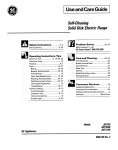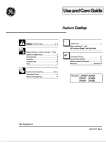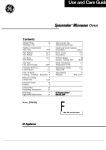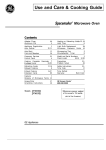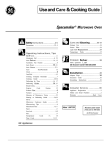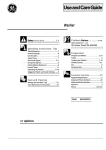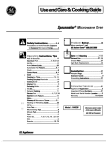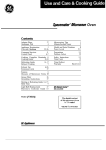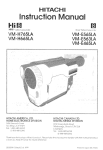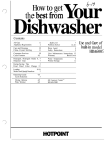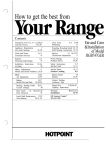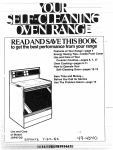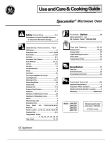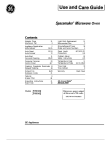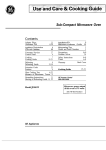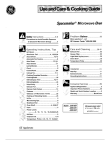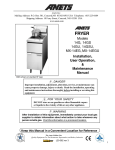Download GE Spacemaker JVM130K User's Manual
Transcript
UseandCare&-ng Guide
SpacemakeP Microwave Oven
Safe~ instructions ....................2-5
Care and Cleaning....................27-29
Precautions .................................................2.5
Exhaust Fan ...................................................28
Grease Filter ..................................................28
Light Bulb Replacement.............................29
Operating Instructions, Tips
Aluminum Foil ..........................................4, 15
Automatic Fan Feature . . . . . . . . . . . . . . . . . . . . . . . . . . . . . . . . ..6
Problem Solver...............................3O
Auto Start/Reminder . . . . . . . . . . . . . . . . . . . ...............12
More questions ?...call
Clock ..................................................................8
GE Answer Center” 800.626.2000
Control Panel ...................................................8
Cooking Complete Reminder ......................7
Cooking
Guide
......................................20-26
Defrosting by Time ...............................12, 13
Defrosting Guide ...................................l8,
Delayed
Cooking
19
............................................9
installation ..........................................29
Adapter Plugs . . . . . . . . . . . . . . . . . . . . . . . . . . . . . . . . . . . . . . . . . . . . . . 29
Extension Cords ...........................................29
Grounding
Instructions
..............................29
Exhaust Fan......................................................6
Express Cook Feature . . . . . . . . . . . . . . . . . . . . . . . . . . . . . . . . . 11
Features . . . . . . . . . . . . . . . . . . . . . . . . . . . . . . . . . . . . . . . . . . . . . . . . . . . . . .......7
Glossary of Microwave Terms ..................14
Consumer Services ...................3l
Heating or Reheating Guide...............l6, 17
Appliance
Hold Time .........................................................9
Model and Serial Numbers ..........................2
Microwave Cookware Guide ....................1 5
Warranty
Microwaving
Tips
Minute/Second
Registration
..................................2
........................................Back
Cover
...........................................6
Timer
...........................9,
10
Power Levels ............................................9- 13
Time Cook. . . . . . . . . . . . . . . . . . . . . . . . . . . . . . . . . . . . . . . . . . . . . . . 10-12
3
GE Appliances
Microwave power ou@ut
of this oven is 750 watts.
(IEC-705 Fst Procedure)
HELP US HELP YOU...
Before using your oven,
read this book carefully.
Be sure your microwave
oven is registered.
Save time and money.
Before you request service...
It is intended to help you operate
and maintain your new microwave
oven properly.
Keep it handy for answers to your
questions.
If you don’t understand something
or need more help, write (include
your phone number):
Consumer Affairs
GE Appliances
Appliance Park
Louisville, KY 40225
[t is important that we know the
location of your microwave oven
should a need occur for
adjustments.
Your supplier is responsible for
registering you as the owner.
Please check with your supplier to
be sure he has done so; also send
in your Consumer Product
Ownership Registration Card. If
you move, or if you are not the
original purchaser, please write to
us, stating model and serial
numbers.
This appliance must be registered.
Please be certain that it is.
Write to:
GE Appliances
Range Product Service
Appliance Park
Louisville, KY 40225
Check the Problem Solver in the
back of this book. It lists causes of
minor operating problems that you
can correct yourself.
Write down the model and
serial numbers.
You’ll find them on a label inside
the oven.
These numbers are also on the
Consumer Product Ownership
Registration Card that came with
your microwave oven. Before
sending in this card, please write
these numbers here:
If you received a
damaged oven...
All these things are normal
with your microwave oven.
● Steam or vapor escaping from
around the door.
● Light reflection around door or
outer case.
● Dimming oven light and change
in blower sound may occur while
operating at power levels other
than high.
● Dull thumping sound while oven
is operating.
● Some TV-Radio interference
might be noticed while using your
microwave oven. It’s similar to the
interference caused by other small
appliances and does not indicate a
problem with your oven.
Immediately contact the dealer (or
builder) that sold you the oven.
Model Number
Serial Number
Use these numbers in any
correspondence or service calls
concerning your microwave oven.
IF YOU NEED SERVICE...
To obtain service, see the
Consumer Services page in the
back of this book.
We’re proud of our service and
want you to be pleased. If for some
reason you are not happy with the
service you receive, here are three
steps to follow for further help.
2
FIRST, contact the people who
serviced your appliance. Explain
why you are not pleased. In most
cases, this will solve the problem.
NEXT, if you are still not pleased,
write all the details—including
your phone number—to:
Manager, Consumer Relations
GE Appliances
Appliance Park
Louisville, KY 40225
FINALLY, if your problem is still
not resolved, write:
Major Appliance Consumer
Action Panel
20 North Wacker Drive
Chicago, IL 60606
~PORTANT SAFETY ~STRUCTIONS
Read dl instructions before using this apptiance.
Precautions to Avoid Possible Exposure
to Excessive Microwave Energy
(a) Do Not Attempt to operate this oven with
Do not mount this appliance over a sink. Install
or locate this appliance only in accordance with
the provided Installation Instructions.
Do not cover or block any openings on the
appliance.
Do not store this appliance outdoors, Do not
use this product near water—for example, in a wet
basement or near a swimming pool.
Do not immerse power cord or plug in water.
Keep power cord away from heated sufiaces.
Do not let power cord hang over edge of table
or counter.
Do not operate this appliance if it has a
damaged power cord or plug, if it is not working
properly, or if it has been damaged or dropped.
c See door surface cleaning instructions in the Care
and Cleaning section(s) of your book.
This appliance should be serviced only by
qualified service personnel. Contact nearest
authorized service facility for examination, repair
or adjustment.
As with any appliance, close supervision is
necessary when used by children.
●
the door open since open-door operation can result
in harmful exposure to microwave energy. It is
important not to defeat or tamper with the safety
interlocks.
(b) Do Not Place any object between the oven front
face and the door or allow soil or cleaner residue to
accumulate on sealing surfaces.
(c) Do Not Operate the oven if it is damaged. It is
particularly important that the oven door close
properly and that there is no damage to the:
(1) door (bent)
(2) hinges and latches (broken or loosened)
(3) door seals and sealing surfaces.
(d) The Oven Should Not be adjusted or repaired
by anyone except properly qualified service
personnel.
●
When using electrical appliances, basic safety
precautions should be followed, including the
following:
●
AWARNING-~oreducetheriskof
burns, electric shock, fire, injury to persons or
exposure to excessive microwave energy:
Use this appliance only for its intended use as
described in this manual.
Read and follow the specific “Precautions to
Avoid Possible Exposure to Excessive Microwave
Energy” in this book.
This appliance must be grounded. Connect only
to properly grounded outlet. See “GROUNDING
INSTRUCTIONS.”
Use this appliance only for ifi intended use as
described in this manual. Do not use corrosive
chemicals or vapors in this appliance. This
microwave oven is specifically designed to heat
or cook food, and is not intended for laboratory or
industrial use.
c For best operation, plug this appliance into
its own electrical outlet, to prevent flickering
of ligh~, blowing of fuse or tripping of circuit
breaker.
●
●
●
●
!
L
●
●
●
●
●
●
To reduce the risk of fire in the oven cavity:
—Do not overcook food. Carefully attend
appliance if paper, plastic or other combustible
materials are placed inside the oven to facilitate
cooking,
—Remove wire twist-ties from paper or plastic
bags before placing bags in oven.
—Do not use your microwave oven to dry
newspapers.
—Do not use recycled paper products. Recycled
paper towels, napkins and waxed paper can contain
metal flecks which may cause arcing or ignite.
Paper products containing nylon or nylon filaments
should be avoided, as they may also ignite.
●
(continued next page)
3
WORTANT SAFETY ~STRUCTIONS
(continued)
—Do not pop popcorn in your microwave oven
unless in a special microwave popcorn accessory
or unless you use popcorn labeled for use in
microwave ovens,
—Do not overcook pohtoes. They could dehydrate
and catch fire, causing damage to your oven.
—Do not operate the oven while empty to avoid
damage to the oven and the danger of fire. If by
accident the oven should run empty a minute or
two, no harm is done. However, try to avoid
operating the oven empty at all times—it saves
energy and prolongs the life of the oven.
Do not use the oven for storage purposes. Do not
leave paper products, cooking utensils or food in the
oven when not in use.
●
If materials inside oven should ignite, keep
oven door closed, turn oven off, and disconnect
power cord, or shut off power at the fuse or circuit
breaker panel.
●
Some producfi such as whole eggs and sealed
containers—for example, closed jars-will
explode and should not be heated in this microwave
oven. Such use of the microwave oven could result
in injury,
●
c Avoid heating baby food in glass jars, even
without their lids; especially meat and egg mixtures.
Thermometer—Do not use a thermometer in
food you are microwaving unless the thermometer
is designed or recommended for use in the
microwave oven.
●
Plastic cookware—Plastic cookware designed
for microwave cooking is very useful, but should
be used carefully. Even microwave-safe plastic
may not be as tolerant of overcooking conditions as
are glass or ceramic materials and may soften
or char if subjected to short periods of overcooking.
In longer exposures to overcooking, the food and
cookware could ignite. For these reasons: 1) Use
microwave-safe plastics only and use them in
strict compliance with the cookware manufacturer’s
recommendations. 2) Do not subject empty
cookware to microwaving. 3) Do not permit
children to use plastic cookware without complete
supervision.
●
When cooking pork, follow the directions
exactly and always cook the meat to an internal
temperature of at least 170°F, This assures that, in
the remote possibility that trichina may be present
in the meat, it will be killed and meat will be safe
to eat.
●
Do not boil eggs in a microwave oven. Pressure
will build up inside egg yolk and will cause it to
burst, possibly resulting in injury.
●
Foods with unbroken outer
“skin” such as potatoes, sausages,
tomatoes, apples, chicken
livers and other giblets, and egg
yolks (see previous caution) should
be pierced to allow steam to escape
during cooking.
Don’t defrost frozen beverages in narrow
necked bottles (especially carbonated beverages).
Even if tie container is opened, pressure can build
up. This can cause the container to burst, possibly
resulting in injury.
●
●
Use metal only as directed in this book. TV
dinners may be microwaved in foil trays less than
3/4” high; remove top foil cover and return tray
to box. When using metal in the microwave oven,
keep metal at least 1 inch away from sides
of oven.
●
. Cookware may become hot
because of heat transferred from the
- heated food. Pot holders may
be needed to handle the cookware.
Foods cooked in liquids (such as pasta) may tend
to boil over more rapidly than foods containing less
moisture. Should this occur, refer to the Care and
Cleaning section(s) for instructions on how to clean
the inside of the oven.
●
4
Not dl plastic wrap is suitable for use in
microwave ovens. Check the package for
proper use.
●
Spontaneous boiling—Under
certain special circumstances,
liquids may start to boil during or
shortly after removal from the
microwave oven. To prevent bums
●
from splashing liquid, stir the liquid
bfiefly before removing the
container from the microwave oven.
. ~~Boilable” cooking pouches and tightly closed
plastic bags should be slit, pierced or vented as
directed by package. If they are not, plastic could
burst during or immediately after cooking, possibly
resulting in injury. Also, plastic storage containers
should be at least partially uncovered because they
form a tight seal. When cooking with containers
tightly covered with plastic wrap, remove covering
carefully and direct steam away from hands and face,
, /
Hot foods and steam can cause
:.~-~ burns. Be careful when opening
* any containers of hot food, including
lP,
●
popcorn bags, cooking pouches andboxes. To prevent possible injury,
direct steam away from hands
and face.
The Exhaust Hood
Have it installed and properly grounded by a
qualified installer. See the special installation
booklet packed with the microwave oven.
The exhaust fan in the oven will operate
automatically under certain conditions (see
Automatic Fan Feature). While the fan is
operating, caution is required to prevent the
starting and spreading of accidental cooking
fires while the exhaust fan is in use. For this
reason:
—Never leave surface units unattended at high
heat settings. Boilover causes smoking and greasy
spillovers that may ignite and spread if exhaust fan
is operating. To minimize automatic fan operation,
use adequate sized cookware and use high heat only
when necessary.
●
●
e
—In the event of a grease fire, smother
flaming pan on surface unit by covering
pan completely with well-fitting lid,
cookie sheet or flat tray.
—Never flame foods under the oven with the
exhaust fan operating because it may spread the
flames.
—Keep hood and grease filters clean, according
to instructions in the Exhaust Feature section, to
maintain good venting and avoid grease fires.
SAVE THESE
INSTRUCTIONS
Optional Accessories
Available at extra cost from your GE supplier.
JX41 Filler Panel Kit.
JX81A charcoal Filter Kit for non-vented
installation.
This microwave oven is UL listed for
installation over electric and gas ranges.
5
MICROWAVING TIPS
● Make sure all cookware used in your microwave
oven is suitable for microwaving. Most glass
casseroles, cooking dishes, measuring cups, custard
cups, pottery or china dinnerware which does not
have metallic trim or glaze with a metallic sheen
can be used. Some cookware is labeled “suitable for
microwaving.”
If you are not
sure if a dish is
microwave-safe, use
this test: Place in the
oven both the dish
you are testing and
a glass measuring
cup filled with one
CUP of water—set the
m~asuring cup either in or next to the dish.
Microwave 1 minute at high. If the dish heats, it
should not be used for microwaving. If the dish
remains cool and only the water in the cup heats, then
the dish is microwave-safe.
Paper towels, waxed paper and plastic wrap
can be used to cover dishes in order to retain moisture
and prevent spattering. Be sure to vent plastic wrap so
steam can escape.
● Some microwaved foods require stirring, rotating
or rearranging. Check the Cooking Guide.
● Steam builds up pressure in foods which are
tightly covered by a skin or membrane. Pierce
potatoes, egg yolks and chicken livers to prevent
bursting.
●
If you use a meat thermometer while cooking, make
sure it is safe for use in microwave ovens.
AUTOMATIC FAN FEATU~
Cooking appliances installed under the oven may, under some heavy usage
conditions, cause temperatures high enough to overheat some internal parts
of the microwave oven.
To prevent overheating from taking place, the exhaust fan is designed
to automatically turn on at a low speed if excessive temperatures occur.
Should this happen, the fan cannot be manually turned off, but it will
automatically turn off when the internal parts have cooled. The fan may
stay on up to approximately 30 minutes after the range and microwave
oven controls have been turned off.
6
w
FEATURES OF YOUR OVEN
‘: ‘ 1
Hmm
mmmmmm
mammmE
■
/
1. Door Handle. Pull to open door. Door must be
securely latched for oven ~o operate.
2. Door Latches.
3. Window with Metal Shield. Screen allows
cooking to be viewed while keeping microwaves
confined in oven.
4. Touch Control Panel and Digital Display. For
detailed information on each feature, see Your Touch
Control Panel section.
5. Hood Controls. Fan. Press HI, LO or OFF.
Light. Press ON or OFF.
6. Grease Filters.
7. Cooktop Light.
8. Oven Floor.
NOTE: Rating plate, oven vent(s) and oven light are
located on the inside walls of the microwave oven.
Cooking Complete Reminder
To remind you that you have food in the oven, the oven
will display “End” and beep once a minute until you
either open the oven door or touch the CLEAR/OFF pad.
This is to certify
that this unit has
been tested in
conformance
with AMCA
Bulletin No. 210.
C.F.M.
at 0.10 WG
215 Vert.
224 Her.
SONES
6.3 Vert.
5.9 Her.
YOUR TOUCH CONTROL PANEL
The Touch Control Panel allows you to set the oven
controls with the touch of a finger. It’s designed to
be easy to use and understand.
When You Plug in the
Oven
The display panel displays five 87s,
18 POWER and all of the oven
functions. After 15 seconds, all
lights disappear and “RESET”
appears in the upper portion.
Touch the CLEAWOFF pad,
set the Clock and oven is ready
for use.
If power is disrupted at any time,
the above sequence recurs, and you
must reset Clock after touching the
CLEAWOFF pad.
1. DISPLAY. Displays time of
day, time or temperature during
cooking functions, power level
being used, cooking mode and
instructions.
2. TIME DEFROST. Gentle
thawing at automatic power
level 3 (Low).
3. TIME COOK I & II.
Microwave for a selected amount
of time using automatic power
level 10 (High).
4. NUMBER PADS. Touch
these pads to enter cooking time,
defrosting time, time of day,
temperature or power level.
5. START. After all selections
are made, touch this pad to start
the oven.
6. AUTO START~EMINDER.
Allows you to program your oven
to begin cooking at a preset time
of day—up to a 12-hour delay. The
Reminder feature can be used like
an alarm clock.
7. VENT FAN. Press HI, LO or
OFF for the different fan speeds.
8
+
uGHT
VENT FAN
L
HI
LO
8. POWER LEVEL. Touch this
pad before entering another power
level number if you want to change
from automatic power level 10
(High) for cooking or power level
3 (Low) for defrosting.
9. MIN/SEC TIMER. This
feature uses no microwave energy.
It functions as either a kitchen
timer, as a holding period after
defrost or as a delay timer before
time or temperature cooking.
10. CLOCK. Touch this pad to
enter time of day or check time
of day while microwaving. To
set clock, first touch CLOCK pad
OFF
IW,
ON
OFF
and then enter time of day. For
example, if time is 1 :30, touch
number pads 1, 3 and O and
“ 1:30” will appear in display.
Then touch START or CLOCK
pad. To reset or change time,
simply repeat above process.
11. CLEAWOFF. When touched,
it shuts off the oven and erases all
settings (except time of day).
12. LIGHT. Touch ON to turn on
the hood light.
HOW TO USE THE M~UTE/SECO~ TMER
u
The Minute/Second Timer
Using a Holding Time
The Minute/Second Timer has three timing
functions:
● It operates as a minute timer.
● It can be set to delay cooking.
Q It can be used as a hold setting after defrosting.
The Minute/Second Timer operates without
microwave energy.
The Minute/Second Timer can also be used to
program a “holding time” between microwave
cooking functions.-The time can range from one
second to 99 minutes and 99 seconds. A holding or
standing time may be found in some of your own
recipes or in the Cooking Guide.
How to Time a 3-Minute Phone Call
Programming Delayed Cooking
1. Touch MIN/SEC TIMER pad.
2. Touch number pads 3,0 and O (for 3 minutes and
no seconds).
3. Touch START. Display shows time counting down.
The timer signals when time is up.
To delay cooking up to 99 minutes and 99 seconds,
touch TIME COOK and enter cook time. Touch
MIN/SEC TIMER and enter number of minutes to
delay cooking. Touch START. Timer will count down
to zero and cooking will begin.
How to Defrost, Hold and Time Cook
Let’s say you want to defrost a frozen casserole for
15 minutes, hold for 10 minutes and then Time Cook
for 25 minutes. Here’s how to do it:
Step 1: Take casserole from freezer and place in oven.
n
TIME
DEFROST
Step 2: Touch TIME
DEFROST pad.
Step 3: Touch pads 1, 5, 0 and O for 15 minutes
defrosting time, (Defrosting is automatically set on
Dower level 3 but can be changed by touching the
POWER LEVEL pad and the ~esir;d power ievel.)
MIN/SEC
TIMER
Step 4: Set standing or hold
time by touching MIN/SEC
TIMER pad.
n
Step 5: Touch 1, 0, 0 and O to hold for ten minutes.
TIME COOK
I &II
Step 6: Touch TIME
COOK I &II pad.
n
Step 7: Touch 2, 5,0 and O for 25 minutes of
cooking time.
n
START
Step 8: Touch START. As each
function is automatically
performed, oven display shows
instructions entered and the
function. When time is up, the
oven signals and flashes “End.”
(<ontinued next page)
9
a
/
HOW TO USE THE MmUTE/SECOm TMER
(continued)
Questions and Answers
Q. What will happen if I accidentally reverse my
defrost, hold and cook instructions?
A. The oven will automatically rearrange your
program. Defrosting will always come first, then hold,
and then the cooking function.
Q. Can I defrost and hold only?
A. Yes. Sometimes you may only want to defrost a
food, hold it, and cook it later. All you need to do is
program in defrost and amount of time. Then program
the hold time. Be sure to put the thawed dish in the
refrigerator promptly.
NOTE: Foods that spoil easily, such as milk, eggs,
fish, stuffings, poultry and pork should not be allowed
to sit out for more than one hour after defrosting.
Room temperature promotes the growth of harmful
bacteria.
Q. I programmed my oven for a specific defrosting
time but it defrosted longer than necessary. What
happened?
A. When instructions conflict, the oven carries out the
last instruction. You may have set the oven to defrost
for 4 minutes, hold for 2 minutes, and then defrost for
6 minutes. In this case, the oven would defrost for 6
minutes and hold for 2 minutes.
COOHNG
Time Cook
Time Cook I & II allows you to microwave for a
selected amount of time.
Power level 10 (High) is recommended for most
cooking, but you may change this for more flexibility.
See the Cooking Guide.
To become better acquainted with time cooking, make
a cup of coffee by following the steps below.
Step 1: Fill a
cup 2/3 full of
water, add I
teaspoon of
instant coffee
and stir to
dissolve. Use a
cup that has no
metal decoration
and is microwave-safe (refer to Microwaving Tips
section). Place cup in oven and close door.
n
TIME COOK
I &II
1
Step 2: Touch TIME
COOK I & 11 pad.
Step 3: Select your time. Touch pads 1,
and O for one minute.
0
n
Because automatic power level 10 is recommended
for this cup of coffee, there is no need to change the
power level, (If power level 10 is not appropriate, see
“How to Change Power Level” on next page.)
Step 4: Touch the START pad.
m
Step 5: When time is up, the oven signals and flashes
“End.” The oven, light and fan shut off.
Step 6: Open the door.
10
Using the Time Cook II Feature
The Time Cook II feature lets you set two time
cooking functions within one program. This is ideal if
you want to change power levels during your cwking
operations. Here’s how to do it.
Step 1: Place food in oven in microwave-safe
container and close the door.
1
Step 2: Touch TIME COOK
&
TIME COOK 1 11
I &II
Step 3: Select your first cook time. For example,
touch 2, 1 and 5 for two minutes and 15 seconds.
Step 4: Touch TIME COOK I & 11.
Step 5: Set your second cook time.
How to Change Power Level
After setting cooking time, touch POWER LEVEL
pad, then touch desired number for new power level.
Step 6: Touch START.
Step 7: At the end of “COOK TIME I,” the second
power level is displayed and “COOK TIME II” is
shown counting down.
Step 8: When time is up, the oven signals and flashes
“End.” The oven, light and fan shut off.
Step 9: Open the door.
The Express Cook Feature
The Express Cook feature is a short-cut method to set
time for 1-5 minutes.
To Express Cook your food or beverage:
Step 1: Touch a number pad (from 1 to 5) that
corresponds with the amount of your desired cooking
time (in minutes). For example, touch the 2 pad for 2
minutes of cooking time.
Step 2: Touch the START pad.
The oven will automatically signal, flash “End” and
shut off at the end of the programmed time.
Questions and Answers
Q. I set my oven for the time called for in the
recipe, but at the end of the time allowed, my food
was not done. What happened?
A. Since house power varies due to time or location,
many Time Cook recipes give you a time range to
prevent overcooking. Set the oven for minimum time,
test the food for doneness and cook the food a little
longer, if necessary.
Q. I touched the number pads and selected my
power level. When I touched START, however, my
oven didn’t come on. Why not?
A. The TIME COOK I & II pad must be touched
before setting the power level otherwise your oven
will not begin cooking.
Q. I want to cook on a power level other than 10
(High). What do I need to do?
A. To change power level, touch the POWER LEVEL
pad, then touch desired number for new power level.
Q. Can I interrupt Time Cook to check the food?
A. Yes. To resume cooking, simply close the door and
press the START pad. The timer must be reset for
cooking to resume unless time is remaining on timer.
11
How to Use Auto Start
The Auto Start feature allows you to program your
oven to begin cooking at a preset time of day—up
to a 12-hour delay.
AUTO START
Step 1: Touch AUTO
START/REMINDER pad.
Step 2: Enter the time you want the oven to start.
(Be sure your microwave oven clock shows the correct
time of day.)
Step 3: Enter your desired cooking program.
Step 4: Touch START pad. The oven will
automatically start at the desired time.
m
How to Use Reminder
The Reminder feature can be used like an alarm
clock, without starting the oven.
Example: It is 7 a.m. and you must remember to
leave for a dentist appointment at 10 a.m.
AUTO START
REMINDER
Step 1: Touch AUTO
STARTREMINDER pad.
Step 2: Enter the time you want the oven to remind
you. (Be sure your microwave oven clock shows the
correct time of day. The reminder time can be set up to
12 hours later).
Step 3: Touch START pad. The
reminder is now set at the time
you programmed, and will signal
you at that time with a beeping
sound until vou o~en the door or m
touch the C~EA~OFF pad. The display will show
REM until the oven door is opened or CLEAWOFF
is touched. The REMinder time may be displayed
by touching the AUTO START/ REMINDER pad.
The time-of-day may be displayed by touching the
CLOCK pad.
DEFROST~G BY TME
Time Defrost
Time Defrost is designed for speedy thawing of
frozen food and is one of the great advantages of
a microwave oven.
Use the Time Defrost setting to quickly thaw foods such
as bread, rolls, vegetables, fruits and frozen dinners.
● Power level 3 is automatically set for defrosting, but
you may change this for more flexibility.
● See your Defrosting Guide for defrosting help.
To become better acquainted with the defrost function,
defrost frozen pork chops by following the steps below.
Step 1: Place a l-lb. package of frozen pork chops in the
oven and close door. Be sure package contains no metal.
Step 2: Touch TIME DEFROST.
TIME
DEFROST
12
Step 3: Select one half of the total defrosting time
recommended in the Defrosting Guide. For example,
touch pads 4,0 and O for 4 minutes.
How to Change Power Level
After setting defrosting time, touch POWER LEVEL
pad, then touch desired number for new power level.
n
START
Step 4: Touch START. When the
cycle is completed, the oven
signals and flashes “End,” then
automatically shuts off.
Step 5: Turn the package over, close the door and repeat
Steps 2 and 3 to set remaining half of defrosting time and
touch START.
Step 6: When the oven signals and flashes “End,” open
the door, remove the package and separate pork chops to
finish defrosting.
Defrosting Tips
● Foods frozen in paper or plastic can be defrosted in
the package.
Family-size, pre-packaged frozen dinners can be
defrosted and microwaved. If the food is in a foil
container, transfer it to a microwave-safe dish.
●
● For even defrosting, some foods need to be
broken up or separated part of the way through the
defrosting time.
●
Check the Defrosting Guide for other defrosting tips.
Questions and Answers
Q. When I press START, I hear a dull, thumping
noise. What is it?
A. This sound is normal. It is letting you know the
oven is using a power level lower than 10 (High).
Q. Can I open the door during defrosting to check
on the progress of my food?
A. Yes. You may open the door at any time during
microwaving. To resume defrosting, close the door
and press START. The oven begins operating if time
is left on timer. If not, reset timer.
Q. Should all foods be completely thawed before
cooking?
A. Some foods should not be completely thawed
before cooking. For example, fish cooks so quickly it
is better to begin cooking while it is still slightly
frozen.
Q. Can I defrost small items in a hurry?
A. Yes, but they will need more frequent attention
than usual. Raise the power level after entering the
time by touching the desired power level pad. Power
level 7 cuts the total defrosting time in about l/2;
Power level 10 cuts the total defrosting time to
approximately 1/3. During either, rotate or stir food
frequently.
Q. Why don’t the defrosting times in the
Defrosting Guide seem right for my food?
A. These times are averages. Defrosting time can vary
according to the temperature in your freezer. Set your
oven for the time indicated in the Defrosting Guide. If
your food is still not completely thawed at the end of
that time, reset your oven and adjust the time
accordingly.
13
GLOSSARY OF MICROWAVE TERMS
When adapting recipes for the microwave, it is best
to stirt with a familiar recipe. Knowing how the food
should look and @te will help when adapting recipes
for microwaving. Foods that require browning or
crisp, dry surfaces will cook better conventionally.
● Moist foods, such as vegetables, fmits, poultry and
seafood, microwave well.
● Rich foods, such as bar cookies, moist cakes and
candies, are suitable for microwaving because of their
high fat and sugar content.
● Reduce conventional cooking time by one-half to
one-third. Check food after minimum time to avoid
overcooking.
● Small amounts of butter or oil can be used for flavoring,
but are not needed to prevent sticking.
● Seasonings may need to be reduced. Salt meats and
vegetables after cooking.
Covering. In both conventional and microwave cooking,
covers hold in moisture, allow for more even heating
and reduce cooking time. Conventionally, partial
covering allows excess steam to escape. Venting plastic
wrap or covering with wax paper serves the same
purpose when microwaving.
Venting. After covering a dish with plastic wrap, you
vent the plastic wrap by turning back one comer so
excess steam can escape.
Arranging Food in Oven. In conventional baking,
you position foods, such as cake layers or potatoes, so
hot air can flow around them. When microwaving, you
arrange foods in a ring, so that all sides are exposed to
microwave energy.
Stirring. In range-top cooking, you stir foods up from
the bottom to heat them evenly. When microwaving, you
stir cooked portions from the outside to the center. Foods
that require constant stirring conventionally will need
only occasional stirring when microwaving.
~rning Over. In range-top cooking, you turn over
foods, such as hamburgers, so both sides can directly
contact the hot pan. When microwaving, turning is often
needed during defrosting or when cooking certain foods,
such as frozen hamburgers.
Standing Time. In conventional cooking, foods such
as roasts or cakes are allowed to stand to tinish cooking
or to set. Standing time is especially important in
microwave cooking. Note that a microwaved cake is
not placed on a cooling rack.
Shielding. In a conventional oven, you shield chicken
breasts or baked foods to prevent over-browning. When
microwaving, you use small strips of foil to shield thin
parts, such as the tips of wings and legs on poultry, which
would cook before larger parts.
Arcing. Sparks caused by too much metal in the
microwave oven or metal touching the side of the oven
or foil that is not molded to food.
Prick Foods to Release Pressure. Steam builds up
pressure in foods that are tightly covered by a skin or
membrane. Prick foods, such as potatoes (as you do
conventionally), egg yolks and chicken livers, to
prevent bursting.
Rotiting. Occasionally, repositioning a dish in the oven
helps food cook more evenly. To rotate 1/2 turn, turn the
dish until the side that was to the back of the oven is to
the front. To rotate 1/4 turn, turn the dish until the side
that was to the back of the oven is to the side.
Basic Microwave Guidelines
Density of Food. In both conventional and microwave
cooking, dense foods, such as potatoes, take longer to
cook than light, porous foods, such as rolls, bread or
pieces of cake.
Round Shapes. Since microwaves penetrate foods to
about one inch from top, bottom and sides, round
shapes and rings cook more evenly. Comers receive
more energy and may overcook. This may also happen
when cooking conventionally.
Delicacy. Foods with a delicate texture, such as
custards, are best cooked at lower power settings to
avoid toughening.
Natural Moisture of food affects how it cooks. Very
moist foods cook evenly because microwave energy
is attracted to water molecules. Food that is uneven in
moisture should be covered or allowed to stand so heat
can disperse evenly.
14
Piece Size. Small pieces cook faster than large ones.
Pieces that are similar in size and shape cook more
evenly. With large pieces of food, reduce the power
setting for even cooking.
Shape of Food. In both types of cooking, thin areas
cook faster than thick areas. This can be controlled in
microwaving by placing thick pieces near the outside
edge and thin pieces in the center.
Starting Temperature. Foods taken from the freezer
or refrigerator take longer to cook than foods at room
temperature. Timings in our recipes are based on the
temperatures at which you normally store the foods.
Quantity of Food. In both types of cooking, small
amounts usually take less time than large amounts.
This is most apparent in microwave cooking, where
time is directly related to the number of servings.
Shelf (on models so equipped). Use the shelf to heat
more than one dish at one time. Take the shelf out
when you are not using it.
~pe of Cookware
Microwave Uses
Foil-lined paper bags and boxes
Avoid using.
Foil baking trays
You can use foil trays that are no higher than 3/4-in. (Foil or metal will
reflect microwaves and cause uneven heating. ) Arcing can occur if foil
is closer than 1 inch to oven walls.
Aluminum foil
Use for shielding.
Metal or partially metal pots, pans,
thermometers, skewers and twist ties
Do not use. Microwave-safe thermometers and skewers are available.
Glass jars and bottles
Generally, glass jars can be used to warm food. However, do not heat
baby food in jars, even without lids, because food will heat unevenly.
Do not warm foods in narrow-necked bottles because pressure can
build up.
Microwave plastics
Cooking and heating.
Paper or Styrofoam plates and cups
Heating and serving of foods and beverages. Styrofoam will melt if
food is too hot or if food is cooked for a long time.
Oven glass and ceramic
Cooking and heating.
Dinnerware
Heating and some cooking. Follow dinnerware manufacturer’s
recommendations. Avoid using dishes with metal trim.
Paper towels, paper napkins and
wax paper
Absorbing moisture, and preventing spatters. Heating and serving of
sandwiches or appetizers. Light covering to hold in steam. Do not use
paper towels that have synthetic fibers, such as nylon, woven into
them, Synthetic fibers may cause the towel to ignite. Avoid using
recycled paper.
Plastic wrap, cooking bags, boil-in
bags and storage bags
Covering to hold in steam (wrap). Cooking (cooking and boil-in bags).
Heating (storage bags).
Paperboard trays used for frozen
entrees and dinners
Cooking and heating.
Plastic trays and plates used for frozen
entrees and dinners
Cooking and heating.
Straw, wicker and wood
Warming.
Cookware Tips
● Always check the cookware manufacturer’s
recommendations before using any cookware
in the oven.
● Before purchasing cookware or preparing food in
cookware, check its size to make sure it will fit
in the oven,
● For best cooking results select a dish that matches
the size or amount of food being prepared.
15
HEATING OR REHEATING GU~E
1. Directions below ~re for heating or reheating already-cooked
foods stored in refrigerator or at room temperature. Use
microwave-safe cookware.
2. Cover most foods for fastest heating. Exceptions are some
sandwiches, griddle foods and baked items.
3. Bubbling tiround edges of dish is normal, since the center is the
lust to heat. Foods heated to 160°F. to 165°F. will provide safe,
Item
palatable results. Adjust temperatures to suit your personal
taste. Let foods stand a few minutes before serving.
4. Be sure foods are heated throughout before serving. Steaming
or bubbling around edges of dish does not necessarily mean
food is heated throughout.
If you use a meat thermometer while cooking, make sure
it is safe for use in microwave ovens.
Amount
Power Level
Time
1/2 cup
I cup
2 to 4 servings
I to 2 servings
3 to 4 servings
Medium (5)
Medium (5)
High (10)
High ( 10)
High ( 10)
2X to 3X min
3 to 5 min.
2 to 4 min.
2 to 4 min.
5 to 7 min.
1 piece
2 pieces
4 pieces
9-in. cake or
I 2 rolls or
doughnuts
I
2
4
6 to 8
1 slice
2 slices
4 slices
9-in. pie
Low (3)
Low (3)
Low (3)
Low (3)
1/2 to I min.
I to I M min.
I X to 2X min.
2 to 4 min.
Medium (5)
Medium (5)
Medium (5)
Medium (5)
High ( 10)
High ( 10)
Meal-High (7)
Meal-High (7)
1/4 to 1/2 min.
1/2 to I min.
1 to I X min.
1 to 2 min.
l/2 to I min.
1 to 1 X min.
2fi to 3 min.
5 to 7 min.
I to 2 cups
I to 2 cups
Meal-High (7)
Meal-High (7)
3 to 6 min.
5 to 7 min.
1 to 2 cups
1 to 2 cups
High ( 10)
High ( 10)
1 to 3 min.
6 to 7 min.
1/2 cup
1 cup
1/2 cup
1 cup
1/2 cup
1 cup
I can (16 oz.)
High (10)
High (10)
High (10)
High (10)
High ( 10)
High (10)
High ( 10)
I to 2 min.
2 to 3 min.
I to 2 min.
2 to 3 min.
2 to 3 min.
3 to 4 min.
3 to 4 min.
2 or 3 pieces
2 or 3 pieces
High ( 10)
High ( 10)
1 to 1 X min.
I to 1 X min.
Appetizers
Dips: cream or processed cheese
Pastry bites: small pizzas, egg rolls, etc.
Saucy: meatballs, riblets,
cocktail franks, etc.
( 1/2 cup per serving)
Tip: Cover saucy appetizers with wax paper. Cover dips with plastic wrap. Microwave pastry bites uncovered to retain their crispness.
Bakery Foods
Cake, coffee cake, doughnuts, sweet rolls,
nut or fruit bread
Dinner rolls, muffins
Pie: fruit, nut or custard
1 slice= 1/8 of 9-in. pie
(use minimum time for custard)
Beverages
Cocoa, other milk based
(6 Oz./cUp)
(9 oz./cup)
Coffee, tea, cider
(6 OZ./CUp)
(9 oz./cup)
Gravies & Sauces
Desserts: chocolate, butterscotch, etc.
Gravies: giblet or creamy
Meat or main dish sauces, such as
spaghetti sauce, etc.
Tip: Cover food to prevent spattering.
Griddle Foods
Pancakes, french toast or waffles:
Plain, no topping
Syrup & butter
Tip: Do not cover.
16
Item
Amount
Power Level
Time
I to 2 pieces
3 to 4 pieces
1 to 2 servings
3 to 4 servings
I to 2
3 to 4
I to 2 servings
High (10)
High (10)
High (10)
High (10)
High (10)
High (10)
High ( 10)
2 to 3 min.
3 to 4 min.
2 to 3 min.
4 to 5 min.
1/2 to I min.
1 to 2 min.
I to 3 min.
1 to 2 servings
3 to 4 servings
I can (16 oz. )
High ( 10)
High (10)
Higb ( 10)
3 to 5 min.
6 to 9 min.
5 to 7 min.
Meats and Main Dishes
Chicken pieces
Hamburgers or meatloaf
(4 oz. per serving)
Hot dogs and sausages
Rice and pasta
(2/3-3/4 cup per serving)
Saucy, main dishes: chop suey, spaghetti,
creamed chicken, chili, stew, macaroni and
cheese, etc.
(3/4-1 cup per serving)
Steaks, chops, ribs, meat pieces
Med-Higb (7)
1 to 2 servings
2 to 4 min.
Meal-High (7)
5 to 7 min.
3 to 4 servings
Thinly-sliced meat
Med-Higb (7)
I to 2 servings
1 to 3 min.
(3 to 4 oz. per serving)
3 to 4 servings
Meal-High (7)
2 to 5 min.
Topped or mixed with sauce
3 to 5 min.
High (10)
1 to 2 servings
3 to 4 servings
High (10)
(2/3-3/4 cup per serving)
5 to 6 min.
Tip: Cover saucy main dishes witb plastic wrap. Cover other main dishes and meats witb wax paper. When heating or reheating 3 to 4 servings
of meat slices or pieces, rotate dish 1/2 turn after half of cooking time.
Plate of Leftovers
Meat plus 2 vegetables
Tip: Cover plate of food with wax paper or plastic wrap.
1 plate
High ( 10)
3 to 4 min.
I to 2 servings
3 to 4 servings
1 to 2 servings
3 to 4 servings
Med-Higb (7)
Med-Higb (7)
Med-Higb (7)
Meal-High (7)
1 to 3 min.
3 to 4 min.
1 to 2 min.
2 to 3 min.
I to 2 servings
3 to 4 servings
I can (10 oz. )
I to 2 servings
3 to 4 servings
I can ( 10 oz. )
Meal-High (7)
Meal-High (7)
Meal-High (7)
High (10)
High (10)
Higb (10)
2 to 3 min.
5 to 7 min.
6 to 7 min.
I fi to 3 min.
4 to 6 min.
4 to 5 min.
1 to 2 servings
3 to 4 servings
1 can (I6 oz.)
I to 2 servings
3 to 4 servings
I to 2 servings
3 to 4 servings
1 can (16 oz. )
High ( 10)
High ( 10)
High (10)
High ( 10)
High (10)
High (10)
High (10)
High (10)
I to 2 min.
2 to 3 min.
4 min.
1 to 2 min.
3 to 4 min.
I to 2 min.
2 to 3 min.
2 to 4 min.
Sandwiches
Meat-cheese filling: with 2 slices of bread
Moist filling: Sloppy Joes, barbecue, ham salad,
etc. in bun ( 1/3 cup per serving)
Tip: Use paper towel or napkin to cover sandwiches.
soups
Milk-based (6 oz. per serving)
Water-based (6 oz. per serving)
Tip: Cover soups with wax paper or plastic wrap.
Vegetables
Large pieces or whole: asparagus spears,
corn on tbe cob, etc.
Mashed
(1/2 cup per serving)
Small pieces: peas, beans, corn, etc.
( l/2 cup per serving)
Tip: Cover vegetables for most even heating.
17
DEFROSTING GU~E
1. Food ptickaged in paper or plastic may be defrosted without
unwrapping. If food is foil wrapped, remove foil and place food
in cooking dish for defrosting. Most food defrosts well using
Defrost (3), For more even defrosting of larger foods, such as
beef, lamb and veal roasts, use Warm ( I).
2. After first half of defrosting time, unwrap package and check
food. Turn food over. if necessary; break apart or separate food
if possible. Shield any warm areas with small pieces of’ foil,
First Half Second Half
Time, Min. Time, Min.
Food
Breads, Cakes
3. Be sure large meats are completely defrosted before cooking.
4. When defrosted, food should be cool but softened in all areas.
If still slightly icy, return to microwave oven very briefly, or let
stand a few minutes,
Comments
[Power Level: Defrost (3)]
Bread, buns or rolls
(8 to 16 oz.)
Cake, frosted, 2 to 3 layer
(17 oz.)
Cake, plain, I layer
Cheesecake, plain or
fruit-topped (17 to 19 oz. )
Coffee cakes
( I I to 14X oz.)
Cream or custard pie
(I4 oz.)
Crunch cakes & cupcakes
Doughnuts
(1 or 2)
(4 to 6)
French toast (2 slices)
Fruit or nut pie (8 in. )
Pound cake (11 X oz.)
Sweet rolls
(8X to I 2 oz.)
2 to 3
1 to 2
Remove metal twist tie. Turn over after first h~lf of time
2 to 3
none
Let stand 5 to 10 minutes before serving.
2 to 3
3 to 6
none
none
Let stand 5 minutes before serving,
6 to 7
none
1 to 2
I to 2
112 to 3/4 each
none
~1~ to I
1 to 2
2
7 to Y
2 to 4
2 to 3
none
1 to 2
1
none
none
2 to 3
Reposition after first half of time, Let stand 5 minutes
before serving.
Rearrange after first half of time.
Turn over after first half of time.
Let stand 5 minutes before serving
Rearrange after first half of time.
Fish & Seafood [Power Level: Defrost (3)]
Fillets:
Pre-packaged ( I lb.)
Freshly frozen ( I lb.)
Shellfish, blocks:
Crab meat
(6-oz. package)
Oysters ( I 2-oz. can)
Scallops ( I -lb. package)
Shellfish, large:
Crab legs, I to 2
(8 to 10 OZ.)
Lobster tails, I to 2
(6 to Y OZ.)
Shellfish, small pieces
(1 lb.)
Steaks (6 to 12 oz.)
Whole fish (8 to 10 oz.)
18
4 to 5
4 to 5
5 to 7
5 to 7
Place unopened package in oven. (If fish is frozen in water, place
in cooking dish. ) Turn package over after first half of time. After
second half of time, hold under cold water to separate.
2
2
4 to 6
4 to 6
4 to 6
4 to 6
Place block in casserole. Turn over and break up with fork after
first half of time.
Place block in casserole. Break up with fork after first half of time.
Place block in casserole. Turn over and break up after first half of
time.
2 to 3
2 to 3
3 to 4
3 to 4
3 to 4
3 to 4
2 to 3
3
none
2 to 4
Arrange in cooking dish with light-underside-up. Turn over after
first half of time.
Arrange in cooking dish, with meaty-side-down. Turn over after
first half of time.
Spread shellfish in single layer in baking dish. Rearrange pieces
after first half of time.
Let stand a few minutes to finish defrosting.
Place fish in cooking dish, Turn over after first half of time. After
second half of time, rinse cavity with cold water to complete
defrosting.
First Half Second Half
Time, Min. Time, Min.
Food
Fruit
[Power Level: Defrost (3)]
Fresh (10 to 16 oz. )
2 to 3
2 to 3
Plastic pouch-l to 2
( 10-oz. package)
1 to 3
3 to 4
Meat
Comments
Place package in oven. Remove foil or metal, After minimum
time, break up with fork. Repeat if necessary.
Place package in oven. Flex package once.
[Power Level: Defrost (3)]
Bacon ( 1 lb.)
2 to 3 per lb,
2 to 3 per lb.
Franks (1 lb.)
2 to 3
2 to 3
Ground: beef & pork
(1 lb. )
(2 lbs.)
3 to 4
6 to 7
3 to 4
6 to 7
12 to 13
12 to I 3
Roast: beef, lamb, veal*
(3 to 4 Ibs,)
8 to 10 per lb.
X to 10 per lb,
Roast, pork
(3 to 4 lbs.)
6 to X per lb.
4 to 6 per lb.
2 to 3
2 to 3
2
2 to 4
3 to 4
1 M to 2fi
Turn over after first half of time. Let stand 5 minutes.
Turn over after first half of time. Let stand 15 minutes.
Rotate package 1/4 turn after first half of time. Let stand 5 minutes.
2
2 to 3
2 to 4 per lb.
2 to 4 per lb.
3 to 5 per lb.
3 to 5 per lb.
Turn over and separate after first half of time. Remove patties as
they thaw,
Place unwrapped ribs in cooking dish. Turn over after first half of
time, After second half of time, separate pieces with table knife.
Let stand to complete defrosting.
Place unwrapped meat in cooking dish. Turn over after first half
of time and shield warm areas with foil. After second half of time,
separate pieces with table knife. Let stand to complete defrosting.
(5 Ibs,)
Sausage, bulk
( l-lb. tray)
( I -lb. roll)
Sausage, links
( 1 to 1 X Ibs.)
Sausage, patties
( 12-oz. package)
Spareribs, pork
(2 to 3 Ibs.)
Steaks, chops & cutlets
Place unopened package in oven. Let stand 5 minutes
after defrc]sting.
Place unopened package in oven. Microwave just until franks can be
separated. Let stand 5 minutes, if necessary, to complete defrosting.
Turn meat over after first half of time.
Turn meat over after first half of time. Scrape off softened meat
after second half of time. Set aside. Break up remaining block and
microwave 1 to 2 minutes more,
Turn meat over after first half of time. Scrape off softened meat
after second half of time. Set aside. Microwave 6 to X minutes
more. Scrape and set aside. Break up remaining block and
microwave 3 to 5 minutes more.
Place unwrapped roast in cooking dish. Turn roast over after first
half of time. Defrost for second half of time. Let stand for 30
minutes to I hour in refrigerator.
Place unwrapped roast in cooking dish. Turn roast over after first
half of time. Defrost for second half of time. Let stand for 30
minutes to I hour in refrigerator.
*Use Warm ( I ) for roasts.
Poultry
[Power Level: Defrost (3)]
Chicken. broiler-frver.
Cut Up (22? to 3 Ibs, j
9 to 11
9 to 1 I
Chicken, whole
(2X to 3 Ibs.)
12 to 14
12 to 14
Cornish hen
5 to 6 per lb.
5 per lb,
Duckling
4 to 6 per lb.
4 to 6 per lb.
~rkey breast (4 to 6 Ibs.)
3 to 5 per lb.
3 to 5 per lb.
Place wrapped chicken in dish. Unwrap and turn over after first
half of time. After second half of time, separate pieces and place
in cooking dish. Microwave 2 to 4 minutes more, if necessary.
Let stand a few minutes to finish defrosting.
Place wrapped chicken in dish. After first half of time, unwrap
and turn chicken over. Shield warm areas with foil. To complete
defrosting, run cool water in cavity until giblets can be removed.
Place unwrapped hen in oven breast-side-up. Turn over after first
half of time. Run cool water in cavity until giblets can be removed.
Place unwrapped duckling in oven. Turn over after first half of
time. Shield warm areas with foil. Run cool water in cavity until
giblets can be removed.
Place unwrapped breast in microwave-safe dish breast-side-down.
After first half of time, turn breast-side-up and shield warm areas
with foil. Defrost for second half of time. Let stand I to 2 hours in
refrigerator to complete defrosting.
19
COOmG GU~E
Breads
Crust on breads will be soft and the outsides will not brown.
[f desired, sprinkle top of batter with cinnamon-sugar mixture,
chopped nuts or other topping for brown color. To increase brown
Food
Container
Coffee cakes
8 in. round or No
square dish
No
8 to 9 in.
tube dish*
Corn bread
Cover
color on upside-down breads, line dish before microwaving with
brown sugar-caramel mixture or savory topping, such as crushed,
canned, french fried onion rings.
Power Level & Time
Comments
Meal-High (7)
8 to 10 min.
Place batter in greased dish,
Meal-High (7)
9 to 11 min.
Sprinkle cooking dish with finely
chopped, canned, french fried onions
before microwaving, Turn out of pan
upside down to serve.
Muffins
Paper-lined
No
High (10)
Use microwave-safe muffin container or
(1 Muffin)
muffin cups
1 to I X min.
homemade muffin cups, made by cutting
(Do not use
(2 to 4 Muffins)
I to 2 min.
down hot drink paper cups. Some muffins
(3 to 6 Muffins)
foil liners. )
2 to 4 min.
may be done before others. Remove
muffins tis they are done, and continue
cooking remaining muffins a few
seconds longer.
Quick breads,
I I to 16 min.
No
Glass loaf
Meal-High (7)
Shield corners after half of cooking
from a mix
dish
time. When done, toothpick inserted in
center will come out clean. Let stand 15
minutes before turning out of dish. Cool.
*lf tube dish is unavailable, microwave in 8 in. round dish with drinking glass placed open-side-up in center.
Cakes and Desserts
1. Always use microwave-safe cookware.
2. Before adding measured amount of batter, grease dishes or line
them with wax paper. (Do not flour. )
3. Cakes are done when toothpick or long skewer inserted into
center comes out clean.
4. Cool cake in dish set directly on heat-proof surface or wooden
board 10 to 15 minutes before inverting.
5. Crust on cakes will be soft. If cake is to be frosted, refrigerate
cake for an hour to firm exterior surface.
6. Chiffon and Angel Food cakes are not recommended for
microwaving.
Food
Container
Cover
Power Level & Time
Comments
Baked apples
or pears
Microwavesafe dish or
casserole
Lid or
plastic wrap
High (10)
2 to 4 min.
per piece
Bar cookies
8 in. square
No
dish
8 in. round or No
square dish
High ( 10)
5 to 7 min.
High (10)
Meal-High (7)
2 min.
4 to 6 min.
Pierce fruit or peel to prevent bursting.
Core and fill center of apple with
2 tablespoons sugar, I teaspoon butter
and 1/8 teaspoon cinnamon. Add
2 tablespoons water for each piece
of fruit.
Grease dish before adding batter.
Cut when cool.
Grease dish before adding batter.
Let stand 5 to 10 minutes to cool
before inverting.
Let tube cake stand 15 to 20 minutes to
cool, before inverting
When cooking several cupcakes, some
will be done before others. Remove
cupcakes as they are done and continue
cooking remaining cupcakes a few
seconds longer.
When done, toothpick stuck in cake
comes out clean. Invert cake onto plate;
let dish stand over cake a few minutes.
Commercial mix
( ] 8 to 20 OZ.)
Cupcakes—6
Pineapple upside
down cake
20
Fluted tube
cake pan
Paper-lined
cupcaker
No
High (10)
11 to 13 min
No
High ( 10)
2X to 3 min.
8 in. round
dish
No
High ( 10)
10 to 12 min
Candies
1. Always use microwave-safe cookware. For easy clean-up, melt
chocolate in paper wrappers seam-side-up, or place chocolate
in paper bowl to melt.
2. Candies which are boiled become very hot; handle cookware
carefully.
Food
Container
Cover
Power Level & Time
Comments
Caramel apples
I pint (2-cup)
measure
No
High (10)
3 min.
Chocolate bark
1 fi-qt. casserole
or bowl
Yes
High ( 10)
3 to 5 min.
Yes
High (10)
No
High (10)
I fi min. to
melt butter,
3fi min.
to melt
marshmallows
15 to 25
seconds
Unwrap a 14-oz. package of caramels into
measuring cup. Add I tablespoon water.
Microwave, stirring every minute. Dip 4
apples into mixture.
Place 12 oz. semi-sweet chocolate pieces
in container. Microwave to melt. Add
I cup whole toasted almonds. Spread
over wax paper on cookie sheet.
Chill until firm.
In large glass bowl, melt 1/4 cup butter.
Add 1O-OZ. package marshmallows, cover
with wax paper and microwave to melt.
Stir in 5 cups crispy rice cereal. Press
firmly into buttered dish.
Cover graham cracker with chocolate and
marshmallow.
Marshmallow crisp 2-qt. oblong
dish
S’Mores
Paper napkin
or paper plate
Cereal, Pasta and Rice
4. Cover pasta and rice while microwaving. When using plastic
wrap, turn back one corner to vent.
5. Stir or rearrange after half of cooking time. Drain pasta
immediately after microwaving.
6. Microwave time and conventional boiling time are about the
same.
1. Always use microwave-safe cookware.
2. For pasta, use about one-half the amount of water needed
for conventional boiling. Add regular amount of salt and
I teaspoon oil (optional, to prevent sticking).
3. For rice or minute rice, use the same amount of water needed
for conventional boiling. Add regular amount of salt.
Food
Container
Cover
Power Level & Time
Oatmeal,
old fashioned
I-qt. casserole
or bowl
No
High (10)
Note: To microwave single-serving packet of instant oatmeal, follow package
directions for amount of water and microwave at High (10) for 1/2 to I minute.
Lid or
2-qt. casserole
High (10)
Rice, minute
plastic wrap
(IX cups)
Lid or
High (10)
3-qt. casserole
Rice, regular
plastic wrap
long grain (1 cup)
Plastic wrap
2-qt. oblong
High (10)
Spaghetti (16 oz.)
dish
Comments
3 to 5 min.
per serving
Increase casserole size for more than one
serving. Increase time about 1 k minutes
for each additional serving you are
cooking. Stir after half of cooking time.
2 to 3 min.
Add I k cups water. Stir after 2 minutes.
18 to 21 min.
Add 2ti cups water. Stir after 10 minutes.
16 to 19 min.
Add 6 to 7 cups water. Rearrange
after 10 minutes.
(continued next page)
21
COO~NG GU~E
(continued)
Cheese and Eggs
1. Eggs may be prepared many ways in the microwave oven.
3. Cook eggs just until set. They are delicate and can toughen if
overcooked.
Always pierce whole yolks before microwaving to prevent
bursting.
2. Never cook eggs in the shell, Do not reheat hard cooked eggs
in the shell, They will explode.
Food
Container
Cover
Power Level & Time
Microwave-safe
2-qt. dish
Cover or
plastic wrap
High (10)
Comments
Cheese
Fondue
To make sauce Make basic white sauce, substituting wine
3 to 5 min.
for milk. Add cheese and microwave at
8 to 9 min.
Medium (5) for 8 to 9 minutes, whisking
every 2 minutes.
Medium (5)
Eggs
Basic eggs
Plastic wrap
Medium (5)
Omelet
Buttered
custard cup
9 in. pie plate
No
High (10)
Poachd eggs
1 X-qt. casserole
Casserole
cover
1 to I X min.
per egg
Melt butter
lfl to V4 min
1 to 2 min.
5 to 6 min.
Boil 2 cups
water.
1/2 to I min.
per egg
High ( 10)
High ( 10)
Medium (5)
Quiche
9 in. pie plate
No
Meal-High (7)
I 7 to 22 min.
Scrambled
Glass
measuring cup
or casserole
No
High ( 10)
3/4 to I min.
per egg
Puncture membrane of yolk to prevent
bursting.
Sprinkle cheese over omelet. Microwave
1/2 to 1 minute until cheese is slightly
melted.
Heat 2 cups hot tap water 5 to 6 minutes
on High ( 10). Break eggs onto plate,
puncture membrane, Swirl boiling water
with spoon, slip in eggs gently. Cover.
Microwave at Medium (5) 1/2 to I minute
per egg. Let stand in water a few minutes.
Pour filling into precooked 9-inch
pie shell.
Scramble eggs with I teaspoon butter and
1 tablespoon milk per egg. Place in oven
and microwave for half of total time. Stir
set portions from the outside to the center.
Allow to stand I or 2 minutes to
finish cooking.
Fish and Seafood
1. Fish is done when it flakes easily when tested with a fork,
Center may still be slightly translucent, but will continue
cooking as fish stands a few minutes after cooking.
2. Cook fish with or without sauce. A tight cover steams fish. Use
a lighter cover of wax paper or paper towel for less steaming.
3. Do not overcook fish. Check at minimum time.
Food
Container
Cover
Power Level & Time
Clams, 6
Pie plate or
shallow dish
Oblong dish
Plastic wrap
High ( 10)
4 to 7 min.
Place in dish with hinged side out.
Wax paper or
plastic wrap
Plastic wrap
High (10)
5 to 7 min.
High ( 10)
7 to 9 min.
Lid or
plastic wrap
High (10)
5 to 9 min.
Plastic wrap
High ( 10)
5 to 7 min.
per lb.
Microwave until fish flakes easily. Turn
steaks over after half of cooking time.
Brush with garlic butter before cooking.
Rearrange after 4 minutes.
Place shrimp in casserole. Add 2 cups
hottest tap water. Cover. Stir after 5
minutes.
Shield head and thin tail with aluminum
foil,
Fillets or
steaks ( I lb. )
Shrimp—1 lb.
(peeled)
Shrimp—1 lb.
(unpeeled)
Whole fish
22
Pie plate or
shallow dish
2-qt. casserole
Oblong dish
Comments
Gravies & Sauces
1. Cover thick, chunky sauces to prevent spattering.
2. Whisk sauces vigorously with wire whisk once or twice while
microwaving.
3. Vary basic white sauce by adding cheese, egg yolks, cream,
wine or herbs.
Food
Container
Cover
Power Level & Time
Comments
Gravies and
sauces thickened
with flour or
cornstarch ( 1 cup)
Melted butter
sauces, clarified
butter ( 1/2 cup)
Casserole
No
Medium (5)
4 to 7 min.
Glass
measure
No
High ( 10)
1 to 2 min.
Casserole, bowl
Yes
High (10)
5 to 7 min.
Microwave fat, flour and salt together to
melt and blend. Whisk in liquid and finish
microwaving. Increase time 1 to 2
minutes per additional cup of sauce.
Microwave butter just to melting. For
clarified butter, bring to boil then let stand
until layers separate. Pour off and use
clear, top layer.
Stir ingredients together, then microwave,
stirring after half of cooking time. Let
stand 5 to 10 minutes to develop flavor,
Casserole
No
High (10)
3 to 4 min.
Thick spaghetti,
barbecue or
sweetisour sauces
(2 cups)
Thin, liquid sauces
(au jus, clam, etc.)
( 1 cup)
Add cornstarch-water mixture to heated
ingredients. Stir well and microwave to
finish.
Meats
1. Always use a cooking bag when cooking beef, lamb, pork or
veal roasts. See package instructions for proper use of cooking
bag.
2. After enclosing roast in cooking bag, place on trivet in
microwave-safe dish.
Food
3. Allow about 10 minutes standing time for most roasts before
carving.
If you use a meat thermometer while cooking, make sure
it is safe for use in microwave ovens.
Container
Cover
Power Level & Time
Comments
Casserole
No
High (10)
Stir after half of cooking time. Add sauce
or casserole ingredients and finish. To
cook frozen block, microwave 10 to
15 minutes, breaking up and stirring
every 5 minutes.
Let stand 5 minutes.
Round dish: arrange 3/4 to I in. apart in
circle around edge of dish.
Oblong dish: arrange 3/4 to 1 in. apart.
Rearrange after half of cooking time.
Beef
Ground, crumbled
(for casseroles
or soup)
(1 lb.)
( 1 % lbs.)
Meatballs
( I lb.)
(2 Ibs,)
Meatloaf
(round loa~
(loaf shape)
Patties
(4 patties per lb.)
I to 2 patties
3 to 4 patties
Pot roasts
5 to 7 min.
7 to 9 min.
Round dish or
oblong disb
Wax paper or
plastic wrap
High ( 10)
Pie plate or
loaf dish
Plastic wrap
Meal-High (7)
or cook to
170°F.
High (10)
Oblong glass
Wax paper
dish (with trivet if
desired) or ceramic
dinner plate
Oblong dish
Cooking bag
or casserole
6 to 8 min.
9 to 12 min.
L(IW (3)
15 to 20 min.
25 to 30 min.
3 to 5 min.
4 to 6 min.
24 to 29 min.
per lb.
Let stand 10 minutes after cooking
Let stand 10 minutes after cooking.
Cover with wax paper or cook uncovered
and turn patties over. If desired add
browning sauce.
Brush with browning sauce and add 1/2
cup water to cooking bag. Turn over after
half of time. Add vegetables if desired
after half of cooking time. Recover
and finish.
(continued next pclge)
23
COO~G GU~E
(continued)
Meats (continued)
Power Level & Time
Container
Cover
(or Internal Tem~.)
Simmered beef
(corned beef or
brisket)
Casserole
Lid or
plastic wrap
Medium (5)
Tender roasts (rib,
high quality rump,
sirloin tip)
Oblong dish
Cooking bag
Medium (5)
Food
Comments
Beef (continued)
120 to
Add I cup water per pound of meat.
Turn over after half of cooking time. Let
meat stand in broth at least 10 minutes
after cooking. For boiled dinner, remove
meat and cook vegetables in broth.
Minutes Internal Turn roasts over after half of cooking
Tern . time. Let meat stand 10 minutes before
er lb.
I 1 to 14
140°F.
carving.
14 to 17
160°F.
*
17 to 20 170°F.
130 rein,
Rare
Medium
Well
Lamb
Roast, leg or
shoulder
2-qt. oblong
dish and trivet
2-qt. oblong
Chops
(1 in. thick) 4 chops dish
Cooking bag
No
Medium (5) Minutes Internal Place roast fat-side-down in microwaveper lb.
Temp. safe dish. Turn over after half of cooking
I
1
to
15
160°F.
time. Let roast stand 10 minutes before
Medium
170°F.
12 to 16
carving.
Well
+
Brush chops lightly with oil. Turn meat
Meal-High (7)
6 to 9 min.
over after half of cooking time.
Pork
Bacon
(per slice)
Microwavesafe plate or
oblong dish
MicrowaveCanadian bacon
2 slices
safe cookware
4 slices
6 slices
Ham, precooked:
2-qt. oblong
canned, butt or shank dish
Ham, slices & steaks 2-qt. oblong
(1 to 2 in. thick)
dish
Pork chops: I in.
Microwavesafe cookware
2
4
6
2-qt. oblong
Pork roast
dish
Paper towel
High (10)
Wax paper
High (10)
Cooking bag
Medium (5)
Wax paper
Higb (10)
Plastic wrap
Medium (5)
3/4 to I min.
I to I M min.
2 to 2X min.
2X to 3 min.
15 to I 9 min.
per lb.
10 to 5 min.
Place fat-side-down in dish. Turn ham over
after half of cooking time.
Turn over or rearrange after 10 minutes.
Brush with barbecue sauce or browning
agent, if desired. Turn over after half of
13 to 6 min. cooking time. Let stand covered 5 to 10
16 to 9 min. minutes before serving.
15 to 9 min. Turn roast over after half of cooking time.
Microwave to an internal temperature
per lb.
Of ] 70°F.
l/2 to 3/4 min. Arrange in single layer. If cooking 6 or
more links, rearrange after half of
per link
cooking time.
Arrange in single layer. Turn over after
3 to 5 min.
half of cooking time.
10 to 3 min.
Cooking bag
Medium (5)
Microwavesafe cookware
Wax paper
High (10)
Pork sausage (raw) Microwave( 1/2 lb.: 4 patties)
safe cookware
Wax paper
High (10)
No
Meal-High (7)
6 to 9 min.
Cooking bag
Medium (5)
17 to 21 min.
per lb,
Pork sausage
(raw), link
Arrange in single layer on paper towels or
on trivet set in dish. Cover with a paper
towel. To microwave more than I layer of
bacon, use an oblong dish and place a paper
towel between each layer of bacon. Cover
with a paper towel to prevent spatters.
Arrange in single layer.
Veal
Chops (1 in. thick)
4 chops
Roast
(shoulder)
24
2-qt. oblong
dish
2-qt. oblong
dish
Brush chops lightly with oil. Turn meat
over after half of cooking time.
Place roast fat- or cut-side-down. Turn
over after half of cooking time. Let roast
stand 10 minutes before carving.
Slice thinly.
k
Poultry
Let turkey breast and other poultry stand for 5 to 10 minutes after microwaving.
Food
If you use a meat thermometer while cooking, make I
I su;eitis safe forusein
microwave
ovens.
I
Container
Cover
Power Level & Time
Pieces
(per piece)
Whole chicken
(8 pieces)
(unstuffed)
Plate or
oblong dish
Oblong dish
Wax paper
High (10)
Wax paper
High ( 10)
Oblong dish
Cooking bag
Meal-High (7)
(stuffed)
Oblong dish
Cooking bag
Meal-High (7)
Square
oblong
Square
oblong
Wax paper
Meal-High (7)
Comments
Chicken
2fi to 3 min.
total
I 1 to I 3 min.
total
I O to I 2 min.
per lb.
13 to 16 min.
per lb.
Arrange in single layer in cooking dish so
thickest meaty pieces are to outside edges
of dish. Turn pieces over and rearrange
after half of cooking time.
Brush with browning agent, if desired. Slit
bag near closure to vent. Close securely
with plastic tie. Cook breast-side-down.
Turn over after half of cooking time.
Cook to 190°F. internal temperature.
Cornish Hens
Halves
Whole (stuffed
or unstuffed)
Duckling
or
dish
or
dish
Wax paper
Meal-High(7)
I 2 to 14 min.
Arrange skin-side-up in dish, on bed of
per lb.
stuffing, if desired.
13 to 15 min.
Place breast-side-down in dish. Turn over
after half of cooking time. Shield tips of
wings and legs with foil.
per lb.
Oblong dish
and trivet
Cooking bag
High ( 10)
Oblong dish
Cooking bag
Medium (5)
6 to 8 min.
per lb.
Microwave breast-side-down for first half
of cooking time. Brush with browning
sauce or broil top surface of cooked bird
until brown and crisp.
I 3 to 15 min.
Tie ribs to breast cavity. Place breast in
per lb.
cooking bag. Close securely with plastic
tie. Place breast-side-down in dish. Slash
bag on underside near closure to vent.
Turn over after half of cooking time.
~rkey
~rkey breast
Vegetables
1. Always use microwave-safe cookware.
2. Salt vegetables after cooking. Salting before cooking may cause
darkening and dehydration of surface.
3. Arrange vegetables, such as asparagus, with the thickest pieces to
the outside of the dish.
Vegetable
Asparagus
(fresh cuts)
4. Cover vegetables when cooking. If using plastic wrap, turn back
one corner to vent.
5. Larger vegetable pieces will take longer to cook than smaller pieces.
6. For more even heating, stir, rearrange or rotate vegetables during
cooking.
Amount
Power Level
Time
Comments
I lb, (3 cups) cut into
1 to 2 in. pieces
High ( 10)
8 to 10 min.
In 2-qt. casserole, place 1/4 cup water.
(continued next page)
25
—
COO~NG GU~E
(continued)
Vegetables
Vegetable
(continued)
Amount
Power Level
Time
Comments
Meal-High (7)
8 to 1() min.
1()-oz. p~ck~ge
High 10)
6 to 8 min
In I X-qt. oblong glass b~king dish. place
1/4 cup wdter. Rotate dish after half of time,
[n I -qt. casserole.
] lb. cut in half
i ()-()x, p~ckage
1 ()-()z, ptickage
High 10)
High 10)
High 10)
I 3 to I 7 min.
7 to 9 min.
7 (o 9 tnin.
In I fi-qt. casserole. place 1/2 CLIp water.
[n 1 -qt. casserole, place 2 t~blespoons water.
In I -qt. casserole. place 1/4 CLIp water.
1 bunch
High ( 10)
20 to 25 min.
[n ~.qt. casserole pltice 1/2 cup water.
1 bunch
( I X to I X Ibs. )
I bunch
( 1 X to I X Ibs. )
lo-oz, ptickagc
1()-oz. pack~ge
High ( 10)
8 to 1 () tnin.
In ?-qt, casserole, place 1/2 cup water,
High ( lo)
I () to 13 min.
High ( 10)
High ( 10)
6 to 8 tnin.
6 to 8 min.
In 2-qt. oblong glass baking dish. pl~ce
1/4 cup water, Rotate dish after hall of time.
In I -qt. casscrolc.
[n I -qt. casserole, place 3 tablespoons wuter,
High ( 10)
9 to 11 min.
In 1 X- or 2-qt. casscrolc, pktce 1/4 cup wtiter.
Higb ( 10)
X to 1 () min.
In 2-or 3-qt. casserole, place 1/4 cup water.
I lb.
i ()-oz. package
High ( lo)
High ( 10)
7 to 9 tnin.
6 to X min.
In I X-qt. c~sserole, place 1/4 cup water.
In I -qt. casserole, place 2 tablespoons water.
I medium head
I medium head
1 ()-oz. ptickage
High ( 10)
High ( I())
High ( lo)
I () to 14 min.
10 to I 7 min.
6 to 8 min.
In ~.qt. casserole, place 1/2 cup water.
In ~.qt. casserole, place 1/2 cup water.
In I -qt. casserole, place 2 tablespoons water.
1()-oz. package
High ( 10)
5 to X min.
In I -qt. casserole, place 2 tablespoons water,
I to 5 Cat”s
High ( lo)
4 to 5 min.
per ear
I ear
2 to 6 ears
High ( 10)
High ( lo)
6 to 7 min.
3 to 4 min.
per e~r
In 2.qt. oblong glJss baking dish, place corn. [f corn
is in husk, use no water; if corn has been husked,
add I/4 cup water. Rearrange after half of time.
Place in 2-qt, oblong glass baking dish.
Cover with vented plastic wrup. Rearr~ngc attcr
half of time.
10-OZ. package
High 10)
5 to X min.
In I -qt. casserole, place 3 tablespoons water.
2 lbs. unshelled
I ()-oz, package
High 10)
High 10)
10 to 12 min.
5 to X min.
In I -qt. casserole, place 1/4 cup water.
In I -qt. casserole. place 2 tablespoons water.
4 potatoes
(6 to 8 oz. each)
1 (6 to 8 oz. each)
High 10)
I 2 to 14 min.
High 1 ())
3 to 5 min.
Peel and cut into I in, cubes. Place in 2-qt.
casserole with 1/2 cup water. Stir after half of time.
Pierce with cooking fork. Place on paper towel
on floor of tnicrowave oven, 1 inch apart in
circular arrangement. Let stand 5 minutes.
1 () to 16 OZ.
I ()-oz. package
High 10)
High 10)
6 to X min.
6 to X min.
In 2-qt. casserole, place washed spinach.
In 1 -qt. casserole, place 3 tablespoons water.
High ( lo)
5 to 7 min.
In 1 fi-qt. ctisserole, ploce 1/4 cup water.
High ( 10)
X to 11 min.
Cut in half and remove fibrous membranes.
In 2-qt. oblong glflss baking dish, place squash
cut-side-down. Turn cut-side-up after 4 minutes.
Asparagus (continued)
(fresh spetirs)
1 lb,
(frozen spears)
Beans
(fresh green)
(frozen green)
(frozen limo)
Beets
(tresh, whole)
Broccoli
(fresh cut)
(fresh spears)
(frozen. chopped)
(frozen spears)
Cabbage
(fresh)
I mediutn head
(about 2 Ibs. )
(wedges)
Carrots
(fresh, sliced)
(frozen)
Cauliflower
(Ilowerets)
(fresh, whole)
(t’rozen)
Corn
(frozen kernel)
Corn on the cub
(fresh)
(1’rozen)
Mixed vegetables
(frozen)
Peas
(fresh, shelled)
(frozen)
Potatoes
(fresh, cubed,
white)
(fresh, whole.
sweet or white)
Spinach
(fresh)
(frozen. chopped
and leaf)
Squash
(1’resh, summer
and yellow)
(winter, acorn
or butternut)
26
I
lb. sliced
1 to 2 squash
(about 1 lb. each)
Keep your oven clean and sweetsmelling. Opening the oven door a
few minutes after cooking helps air
out the inside. An occasional
thorough wiping with a solution of
baking soda and water keeps the
inside fresh.
Don’t use sharp-edged utensils
on your oven. The inside and
outside oven walls can be scratched.
The control panel can be damaged.
BE CERTAIN POWER IS OFF
BEFORE CLEANING ANY
PART OF THIS OVEN.
How to Clean the Inside
Walls and floor. Some spatters can be removed with
a paper towel, others may require a damp cloth.
Remove greasy spatters with a sudsy cloth, then rinse
with a damp cloth. Do not use abrasive cleaners on
oven walls. NEVER USE A COMMERCIAL OVEN
CLEANER ON ANY PART OF YOUR
MICROWAVE OVEN.
Door (inside). Window: Wipe up spatters daily and
wash when soiled with a damp cloth. Rinse
thoroughly and dry.
Metal and plastic parts on door: Wipe frequently with
a damp cloth to remove all soil. DO NOT USE
ABRASIVES, SUCH AS CLEANING POWDERS
OR STEEL AND PLASTIC PADS. THEY WILL
MAR THE SURFACE.
Special note when using Brown ‘N Sear Dish: If
grease is present, high heat generated on bottom of a
Brown ‘N Sear dish may cause the grease to burn
onto the oven tray. This may be removed with a
cleanser such as Bon Ami’” brand cieanser.
After using Bon Ami’” brand cleanser, rinse and dry
thoroughly, following instructions on can. Do not use
Bon Ami[” brand cleanser on the painted surfaces such
as the walls. [t may scratch the paint.
How to Clean the Outside
Case. Clean the outside of your oven with soap and
damp cloth, rinse with a damp cloth and then dry.
Wipe the window clean with a damp cloth. Chrome
trim is best wiped with a damp cloth and then with a
dry towel.
Control Panel. Wipe with a damp cloth. Dry
thoroughly. Do not use cleaning sprays, large amounts
of soap and water, abrasives or sharp objects on the
panel—they can damage it.
Door Surface. When cleaning surfaces of door and
oven that come together on closing the door, use only
mild, non-abrasive soaps or detergents applied with a
sponge or soft cloth.
Power Cord. If the cord becomes soiled, unplug and
wash with a damp cloth. For stubborn spots, sudsy
water may be used, but be certain to rinse with a
damp cloth and dry thoroughly before plugging cord
into outlet.
27
The exhaust hood feature on your microwave oven is equipped with two
metal filters which collect grease.When the fan is operated, air is drawn
up through the filters. Depending on your model, it is either discharged
through the provided venting to the outside or drawn through a charcoal
filter and recirculated.
CHARCOAL FILTER
(on some models)
~-~
j~‘
REUSA.BLE GREASE FILTERS
(on all models)
Reusable Grease Filters
(on al] models)
The grease filters should be cleaned at least once a month. Never operate your hood without the filters in place.
In situations where flaming might occur on surfaces below hood, filter will stop the entry of flames into the unit.
To Remove Grease Filter
To Clean and Replace Grease Filter
To remove grease filter,
grasp the “finger hold”
on the filter and slide to
the rear. Then pull filter
downward and to the
front. The filter will
drop out.
To clean grease filter, soak it and then agitate filter
in solution of hot water and detergent. Don’t use
ammonia or ammonia products because they will
darken the metal. Light brushing can be used to
remove embedded dirt.
Rinse, shake and remove moisture before replacing.
To replace grease filter, slide the filter in the frame
slot on the back of the opening.
Pull filter upward and to the front to lock into place.
Charcoal Filter
\—”-”-
(on some models)
Some models are not vented to the outdoors; they
recirculate the air instead. These models are equipped
with a disposable charcoal filter that helps remove
smoke and odors caused by cooking on your range.
The disposable charcoal filter should be replaced
when it is noticeably dirty or discolored (usually
after 6 to 12 months, depending on hood usage). Order
Part No. WB02X9883 from your GE supplier. DO
NOT CLEAN THIS FILTER. DO NOT OPERATE
YOUR HOOD WITHOUT ALL THREE FILTERS
IN PLACE.
To Remove Charcoal Filter
To Install Charcoal Filter
To remove the
charcoal filter,
disconnect power
at main fuse or
circuit breaker
panel or pull plug.
Remove the top
grille by taking off
2 screws which hold it in place. Grasp filter and slide
toward front of oven. It will slide right out.
To install a new
filter, remove
plastic and other
outer wrapping
from the new
filter. Insert filter
into top opening
of oven as shown.
It will rest at an angle on two side support tabs and
in front of right rear tab. Replace grill and secure with
2 screws.
28
Cooktop Light
To replace
cooktop light, first
disconnect power
at main fuse or
circuit breaker
REMOVE SCREW
panel or pull
plug.
Remove screw on right side of light compartment cover
and lower cover until it stops.
Be sure bulbs to
be replaced are
cool before
removing. Break
the adhesive seal
by gently
unscrewing the
bulbs. Replace
with 40-watt incandescent bulbs (WB02X4253)
available from your GE supplier. High intensity 40-watt
bulbs (40S 1 lN/1), which are available in supermarkets
and hardware stores, may also be used for replacements.
Raise light compartment cover and replace screw.
Connect electrical power to microwave oven.
Oven Light
To replace your oven light, first
disconnect power at main fuse or
circuit breaker panel or pull
plug. Remove the top grill by
taking out the 2 screws that hold it
in place.
This appliance must be grounded.
In the event of an electrical short
circuit, grounding reduces the risk
of electric shock by providing an
escape wire for the electric current.
This appliance is equipped with a
power cord having a grounding
wire with a grounding plug. The
plug must be plugged into an outlet
that is properly installed and
grounded. (Fig. 1)
WARNING–improper
use of the grounding plug canresult in a risk of electric shock.
Next, remove the single screw
located above door near center of
oven that secures light housing.
Replace burned-out bulb with a
30-watt incandescent bulb
(WB02X4235), available from
your GE supplier.
PREFERRED
METHOD
@@
+
R
Fig. 1
Ensure proper ground
exists before use
Consult a qualified
or
. . .- electrician
.
..
service tecnmclan lr the grounalng
instructions are not completely
understood, or if doubt exists as to
whether the appliance is properly
grounded.
Clean off the grease and dust on
hood surfaces often. Use a solution
of warm water and detergent.
About 1 tablespoon of ammonia
may be added to the water. Take
care not to touch the filters and
enamel surfaces with this solution;
ammonia will darken metal.
Where a standard two-prong
wall receptacle is encountered, it
is your personal responsibility and
obligation to have it replaced with
a properly grounded three-prong
wall receptacle.
Do not under any circumstance
cut or remove the third (ground)
prong from the power cord.
Do not use an adapter plug with
this appliance.
Do not use an extension cord
with this appliance.
29
QUESTIONS?
USE THIS PROBLEM SOLVER
PROBLEM
POSSIBLE CAUSE
OVEN WILL NOT
COME ON
● A fuse in your home may be blown or the circuit breaker tripped. Replace fuse
or reset circuit breaker.
CONTROL PANEL
LIGHTED,
YET OVEN WILL
NOT START
●
Unplug your microwave oven, then plug it back in.
●
Make sure 3-prong plug on oven is fully inserted into wall receptacle.
●
Door not securely closed.
●
START pad must be touched after entering cooking selection.
● Another selection entered already in oven and CLEAWOFF pad not touched
to cancel it.
● Make sure you have entered cooking time after touching TIME COOK I & II
pad.
CLEAWOFF pad was touched accidentally. Reset cooking program and touch
START pad.
●
FOODS ARE EITHER
OVERCOOKED OR
UNDERCOOKED
Cooking times may vary because of starting food temperature, food density or
amount of foods in oven. Touch TIME COOK I & 11 pad and additional cooking
time for completion.
●
● Incorrect power level entered. Check Cooking Guide for recommended
power level.
● Dish was not rotated, turned or stirred. Some dishes require specific
instructions. Check Cooking Guide or recipe for instructions.
● Too many dishes in oven at same time. Cooking time must be increased when
cooking more than one food item. Check Cooking Guide time recommendations.
The cooktop lamp is located directly below the oven floor. When the lamp
is on, the heat it produces makes the oven floor get warm. This is normal.
FLOOR OF THE
OVEN IS WARM,
EVEN WHEN THE
OVEN HAS NOT
BEEN USED
●
All these things are normal with your microwave oven:
Steam or vapor escaping from
around the door.
● Light reflection around door or
outer case.
●
Dimming oven light and change
in blower sound may occur while
operating at power levels other
than high.
● Dull thumping sound while oven
is operating.
●
Some TV-Radio interference
might be noticed while using your
microwave oven. It’s similar to the
interference caused by other small
appliances and does not indicate a
problem with your oven.
●
If you need more help... call, toll free: GE Answer Center @/ 800.626.2000/ consumer information service
30
Wdll Be There
—
With the purchase of your new GE appliance, receive the
assurance that if you ever need information or assistance
from GE, wdll b; there. All you have to do is call–toll-free!
GEAnswer Center@
8006262000
~l:i(~V~I” yoL1l- (lLleStio Il 21bo Ll( 2111)’ (;:
In-Home Repair
Serv;ce
Service Contracts
80MEXARES
(80M32-2737)
YOLI can have the secure fkeling th:~(
(;E (;onsunler Service will still be
there afier your warriinty expires. Purchase a (1E contract while your warranl.y is still in efl.ect and you’ll receive
Ll substantial cliscount. With:1 rnultipleyear contract, you’re assured of’filture
selTice at today’s prices.
i~ (; Econsurner sel~iceprof’essiO1l:il”
will provide expert rep~iir service,
scheduled ~~( ;i time th;l(’s convenient
for yoLI. Many (;k~ (;onsunlel° Service
c:onlp:iny-()[~el-~~ted localions ofl’elyou service today or tomorrow, or iit
yollr{:orlvenience” (7:()() a.m. 10 7:()() p.m.
weekdays, {):00 a.m. to 2:()() p.m. S:{turdays). Our factory-trained technicians
know your appliance inside and outs() most rep;iirs c;in be h:mdlecl in just
one visit.
80@62&2224
major iipplii~nce, (;E Answer (lcntei””
infi)rnl~t[ion sellicc is ;iv~iiliible t.()
help. Y(){lr c~d-~lnd your qLlestionwill be ~mswered promptly ~md
cOLII-I.eoLISly.” And you c:m call any
time. (Jk; Answer (;enter’” sc~vice is
open 24 }](}L1]-S ii d:iy, 7 d;iys ii week.
Telecommunication Detice for tie
Deaf
Parts andAccessories
.
80@626-2002
IndividuA qudfied to service their
ow appliances can have needed
parts or accessories sent directly to
their home. The (;E pzirts system provides :{ccess to over 47,000 parts... anct
all (JE (;ertuine Renewal P~~rts :ire
fLllly warmnted. VISA, Master(lard
and Discover cards ~~re accepted.
User maintenance instructions
contained in this booHet cover procedures intended to be performed by
any user. Other servicing gener~y
shodd be referred to qudfied service personnel. Caution must be
exercised, since improper servicing
may cause unsafe operation.
S, C.!ONA.A
.,...,. ,.,,.”,.” m..
. . . . . . . . . . . . . . . . . . . . . . . . . .....
“..,.. .=-.
!.,
kr Customers With
Special Needs...
Upon request., (1E will provide Ilraille
c(mt.rols for a variety of’(lk; appliances
imd 21 brochure [() assist in pl:mning it
barrier-fi-ee kitchen fi)r persons with
limited mobility. ‘I’() obLiin lhese items
free of’charge, c:L1l 800.626.2000.
(;(~nsumers wi[h impaired hearing
or speech who have access (() a TI)I)
or ii c{)nventional teletypewriter may
call 800-TDD-(~~C (800-833-4822)
to request information or service.
YOUR GE MICROWAVE OVEN
WARRANTY
Save proof of original purchase date such as your sales slip or cancelled check to establish warranty period.
1’
WHAT IS COVERED
FULL ONE-YEAR WARRANTY
For one year from date of original
purchase, we will provide, free of
charge, parts and sewice labor in
your home to repair or replace any
pati of the microwave oven that
fails because of a manufacturing
defect.
LIMITED ADDITIONAL
NINE-YEAR WARRANTY
For the second through tenth year
from date of original purchase, we
will provide, free of charge, a
replacement magnetron tube if the
magnetron tube fails because of a
manufacturing defect. You pay for
the service trip to your home and
service labor charges.
WHAT IS NOT COVERED
“ Service trips to your home to teach
you how to use the product.
Read your Use and Care material.
If you then have any questions
about operating the product, please
mntact your dealer or our
Consumer Affairs office at the
address below, or call, toll free:
GE Answer CenteP
800.626.2000
consumer information service
● Improper installation.
If you have an installation problem,
contact your dealer or installer.
You are responsible for providing
adequate electrical, gas, exhausting
and other connecting facilities.
This warranty is extended to
the original purchaser and any
succeeding owner for products
purchased for ordinary home use in
the 48 mainland states, Hawaii and
Washington, D.C. In Alaska the
warranty is the same except that it is
LIMITED because you must pay to
ship the product to the service shop
or for the service technician’s travel
costs to your home.
All warranty sewice will be provided
by our Factory Service Centers or
by our authorized Customer Care’
servicers during normal working
hours.
Call 1-800-GE CARES (1-800-4322737).
Replacement of house fuses or
resetting of circuit breakers.
● Failure of the product if it is used for
other than its intended purpose or
used commercially.
● Damage to product caused by
accident, fire, floods or acts of God.
WARRANTOR IS NOTRESPONSIBLE
FOR CONSEQUENTIAL DAMAGES.
●
I
~
I
Some states do not allow the exclusion or limitation of incidental or consequential damages, so the above limitation or exclusion
may not apply to you, This warranty gives you specific legal rights, and you may also have other rights which vary from state to state,
To know what your legal rights are in your state, consult your local or state consumer affairs office or your state’s Attorney General.
Warrantor: General Electric Company
If further help is needed concerning this warranty, write:
Manager—Consumer Affairs, GE Appliances, Louisville, KY 40225
Part No. 164 D2588P087
Pub. No. 49-8283
2-92
CG
JVM130P
JVM131 b
































